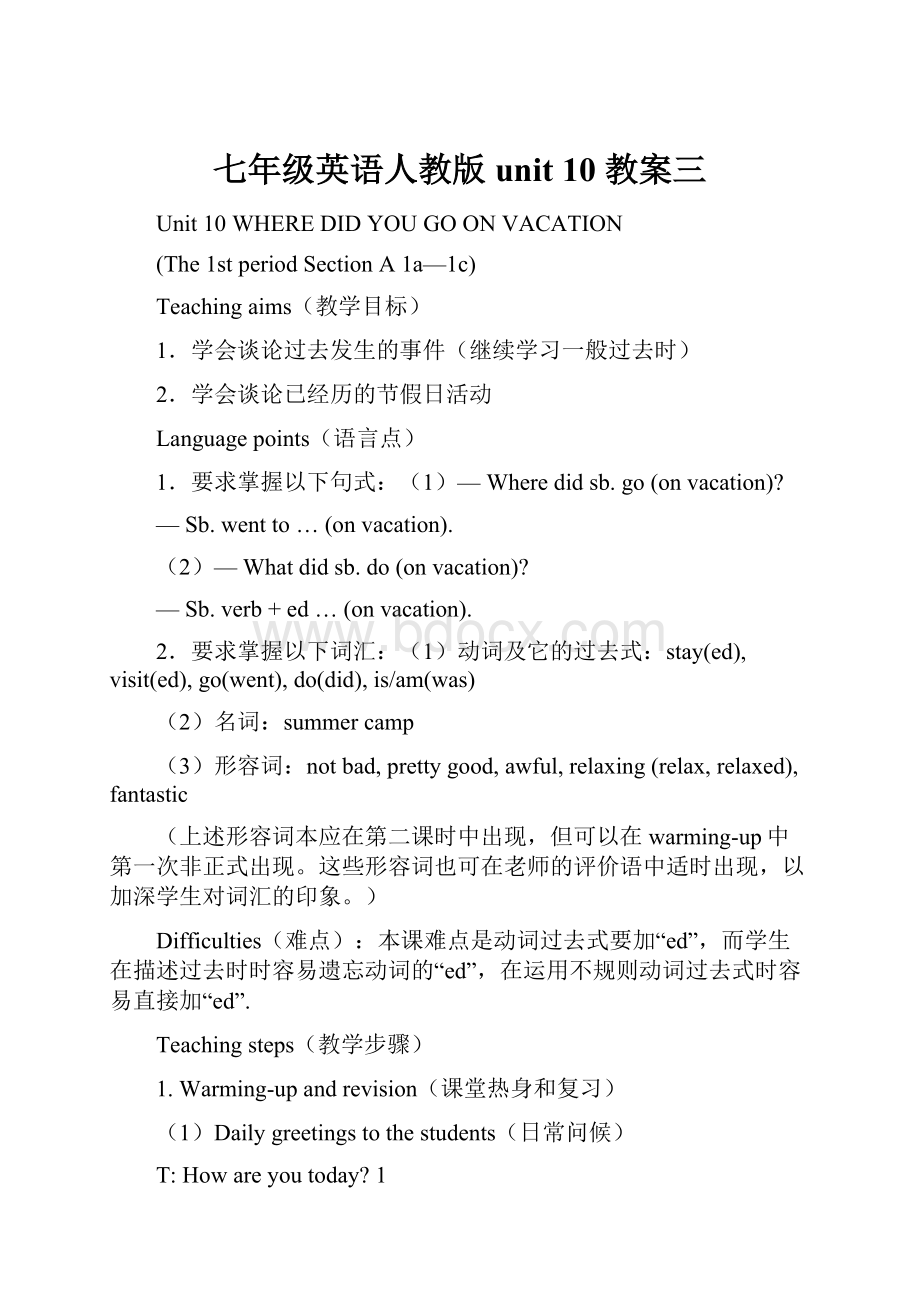七年级英语人教版 unit 10 教案三文档格式.docx
《七年级英语人教版 unit 10 教案三文档格式.docx》由会员分享,可在线阅读,更多相关《七年级英语人教版 unit 10 教案三文档格式.docx(33页珍藏版)》请在冰豆网上搜索。

1
S:
Iam(fine/great/OK/verygood).Howaboutyou?
Iam(notbad/prettygood/awful/terrible).
Howistheweathertoday?
Itis(nice/great/fine/good/beautiful/notbad/prettygood/fantastic/bad/terrible/awful/hot/cool/cold/windy/rainy…).
Howwastheweatheryesterday?
ItWAS2…yesterday.
(2)Revision(复习)
Howwasyourweekend?
3
Itwas…
Whatdidyou/yourfather/yourmother/yourbestfrienddolastweekend?
4
I/Myfather/Mymother/Mybestfriend…
ThatWASfun/great/fantastic/relaxing/notbad/prettygood/terrible/awful…(老师根据学生回答给出多种评价。
教学设计说明
1.这两问题是为了操练形容词。
建议让多个Ss作答。
鼓励他们用不同的形容词。
若回答雷同,T可在S反问“howaboutyou?
”时,刻意给出不同回答,在合适的情景下带出将要学习的词汇,如:
notbad,prettygood,fantastic,terrible,awful。
T课前板书这些词。
2.此问重点操练was。
建议T用夸张语调重读was,并用彩色粉笔板书。
3.该问题除了继续操练已有形容词回答问题外,T鼓励但不必强求学生试用上面第一次出现的新词,因为这不是本课要求掌握的。
4.该问题是为了复习第九单元的动词词组。
2.Presentation(呈现新知识)
(从复习中引出)Wheredidyougolastweekend?
5
Iwentto…
Wheredidyougoonvacationlastsummer?
Doyouremember?
Iwentto…(onvacationlastsummer)6.
Doyouliketoleavehomeanddosomethingfunwithlotsoffriendsforafewdaysonvacation?
7
Yes,Ido.
Thenyoucangotothesummercamp8.
3.Workon1a(完成P591a)
NowlookatthepicturesonP59.Pleasematchtheactivitieswiththepictures.
(使用教材第59页上图片的挂图,给学生一分钟时间独立或和同桌讨论来完成此项任务。
在此基础上组织下面操练)9
Eg:
T:
(教师诱发S1说出“I’mtheboyinthepurplepants.”,然后问)Wheredidyougo?
S1:
Iwenttothebeach.
(诱发S2)Wheredidyougo?
S2:
Ivisitedmyuncle.
Drill:
S1:
Iamthegirl/boyinthe…
Wheredidyougo?
IwenttoNewYorkCity.
…
4.Workon1b(完成P59-1b)
Nowlet’slistentothetape,findoutthenamesofthepeople,andnumberthepeople1-5inthepicture.10
Nowlet’schecktheanswers.TheboyinthebluepantsisBrad.
TheboyintheshortsisXiangHua./TheboyinthebrownpantsisTom./ThegirlintheyellowpantsisSally.
5.Workon1c(完成P59-1c)
ThegirlinthepurplepantsisTina.WheredidTinagoonvacation?
11
Shewenttothemountains.
Nowcanyoutalkabouttheotherchildren’svacation?
Pleaseuse“Wheredid…goonvacation?
”.
6.Listenandrepeat(听音跟读)
Nowlet’slistentothetapeandrepeat.Pleasetrytoreadlikethetape.12(文字材料见P98)
5.如果Ss对课本中出现“Ivisitedmyfriend”这个回答有异议,T可补充说明在交际语言中,这也可以回答Wheredidsb.go?
6.对有能力的Ss,要求加上括号里的部分完整回答,T板书go-went
7.此句较长,要求T放慢语速,并重复此问题。
8.T板书summercamp,可给中文帮助Ss理解该单词。
9.T简笔画出1a图中所有人物,复制若干,分发给Ss,先由持图S说明Iamtheboy/girlinthe…(为完成1b作好铺垫),再由其他S问:
Wheredidyougo?
持图S再回答:
Iwentto…。
这种活动可使Ss操练:
Where…?
句型,并检验1a完成情况。
活动前先由T和Ss做示范对话,再由S和S对话。
对正确地使用了过去式回答的同学进行表扬。
板书动词原形及过去式。
10.播放磁带。
如有需要,T可播放磁带两遍。
如有必要,也可以让S以四人小组为单位,讨论答案。
检验答案时,先由T给例句,再由S模仿回答。
11.T板书呈现“Wheredid…goonvacation?
”;
并可以根据班级具体情况,可以不给S准备时间,直接叫同桌起来提问回答。
12.Ss应听一句跟读一句。
T特别强调语音语调的模仿。
建议T把听力内容打印好发给S,以便他们在听音模仿时可以标上语调。
可以先全班跟读,再让S个体跟读。
T可以根据实际情况来决定跟读的时间。
7.Followup(进一步扩展)
Nowit’syourturntomakeupyourowndialogues.Pleaseworkwithyourgroup(fourstudentsinonegroup)andaskeachotherquestionsaboutwhereyouandyourfriendwentonvacationlastsummer.13
Eg:
A:
Hi/Hey,…Wheredidyougoonvacation?
B:
Iwentto…
Cool/Fantastic/…Andwheredid…?
He/Shewentto…)
8.Homework
Oralwork:
(1)Listento1b,readandreciteit.(听读背诵1b中的对话)
(2)Goonmakingupyourdialogueswithyourgroupmembersandpolishit.(继续和小组成员编对话。
并完善对话。
Writtenwork:
(1)Copythephrasesin1atwiceinitsoriginalform.(用原形抄1a词组两遍)
(2)WriteaboutthepicturesonP59likethesentencesin1c.(模仿1c中的句子,用Brad,Sally,XiangHua,Tom替换Tina,并作出不同的回答。
13.T根据Ss的实际水平,可以让Ss自由发挥编对话,也可以板书对话框架,以降低难度。
根据课堂时间安排,检查对话若干。
要求S在听时,记录对话中出现的动词过去式及原形。
对话结束后,让同学朗读记录下来的动词过去式,以此强化学生对动词过去形式的意识。
(The2ndperiodSectionA2a—2c)
1.继续谈论过去发生的事件(继续学习一般过去时的用法)
2.继续谈论已经历的节假日活动。
.
(1)—Didyou/he/she/theydosth.?
—Yes,I/we/he/she/theydid.
—No,I/we/he/she/theydidn’t.
(2)Sth.wasnice/…
2.需要了解的景点:
CentralPark—CentralParkisthebiggestparkinNewYorkCity.Highbuildingsareallaroundthepark.It’saplacewhereNewYorkersliketobike,jog,picnic,walk,andboat.(建议老师找几张中央公园的图片。
Difficulties:
(难点):
1.Did…dosth?
中的动词要用原形,学生容易使用过去式。
1.Warming-upandrevision(课堂热身和复习)
Goodmorning/afternoon.
Whatdayisittoday?
———Whatdaywasityesterday?
What’sthedatetoday?
——Whatwasthedateyesterday?
Iseverybodyheretoday?
—Waseverybodyhereyesterday?
Howissb.today?
—Howwashe/sheyesterday?
1
WhatdoweusuallydointheEnglishclass?
2
Welearnsomenewwords/listentothetape/answerquestions/makeupdialogues/…
WhatdidwedointheEnglishclassyesterday?
Welearnedsomenewwords/listenedtothetape/answeredquestions/madeupdialogues/…
Now,areyoureadyforyourdialogues?
Whowouldliketoactoutyourdialoguefirst?
(检查两到三组的对话。
老师应对学生的对话给予尽可能积极的评价。
例如:
Yourdialogueisinteresting/prettygood/fantastic/…
Youdidagreatjob!
Yourpronunciationisbeautiful.
Youractingisfantastic/…/
Yourdialogueisinteresting,butcanyoumakeyourpronunciation/actingbetternexttime?
1.这些问题的设计是让Ss比较be动词的一般现在时和一般过去时。
2.此问句是为了与3的问句作比较。
若S回答有困难,T可以用:
“Dowelearnanynewwords/…?
”这样的一般疑问句形式帮助他们回答,或扩充回答内容。
3.若S回答有困难,T可用:
“Didwelearnanynewwords/…?
由于这是第一次出现一般过去式的一般疑问句形式,S可以只给出“Yes,(wedid).”“No,(wedidn’t).”的回答。
括号里的内容,由T帮助S初步了解完整回答的形式。
这是为正式引出Did…?
作铺垫。
(根据学生对话内容提问)4
WheredidTom(假设你学生名字是Tom)goonvacation?
Iforgot.Didhegoto…?
Yes,hedid./No,hedidn’t.(Hewentto…onvacation.)
(鼓励学生回答括号里面内容)
(askTom)Tom,doyouoftengoto…onvacation?
S(Tom):
Yes,Ido.(S可能性回答1)
Really?
Andyouwentto…onvacationlastsummertoo.
No,Idon’t.(S可能性回答2)
Butyouwentto…onvacationlastsummer.
Yesterday,wealsotalkedaboutthispictureonp.59.Theywenttodifferentplacesonvacation.
Wheredidyougoonvacation?
Didyougo5tothebeach?
Yes,Idid./No,Ididn’t.(Iwentto…)
Doyouoftengoto…onvacation?
No,Idon’t.
Butyouwentto…onvacationlastsummer.6
3.Playagameandpracticemoreonthepattern“Didyou…?
”
Now,let’splayaguessinggame.IwouldlikeAtohavealookatthisnote,butAcan’ttellyouwhatitsays.Awillaskyouwhere…andYoucanonlyask“Didyougoto…?
/Didyoudo…there”,tofindouttheanswers.7
WheredidIgoonvacation?
Didyou…?
No,Ididn’t./Yes,Idid.
WhatdidIdothere?
Didyou…there?
4.Workon2a(完成P60-2a)
Now,wearegoingtomeetsomenewfriends,theyareNancy,KevinandJulie(有必要让学生跟读这些英文名字。
).Listentothetape,andfindoutwhereNancy,KevinandJuliewentontheirvacation.WheredidNancy/Kevin/Juliegoonvacation?
8
NancywenttoNewYorkCity./Kevinwenttothebeach./Juliestayedathome.
4.T可用男生和女生,或谁和谁来作为问题的对象,让Ss练到he/she/they各种人称,T用“Really?
And…/But…”等话语进行补充陈述,是为了让Ss对一般现在时和一般过去时有所比较。
如果由于种种原因,T没法以前天的对话作业为此话题提供情景,可以直接对Ss实际情况发问,可对四个左右Ss发问,让Ss对一般现在时和一般过去时有所比较。
5.建议T用夸张的语调重读did和go,并板书该句式,用彩笔写did和go。
6.通过比较Do…?
和Did…?
,使S更清楚Did…?
的用法,并了解这两个问句中动词都用原形。
7.游戏目的是为了操练Did…?
句型。
在反复提问中充分练习了问句中的动词原形。
具体操作:
给A看事先准备好的小纸条,上面写Iwenttothepark.Iplayedvolleyballthere.由A发问:
WheredidIgo?
由其他S用Didyougoto…?
的句型猜测,A应对每个猜测给出No,Ididn’t.或Yes,Idid.的回答。
猜出去哪儿后,A再发问WhatdidIdothere?
由其他S用Didyou…there?
的句型猜测,A应对每个猜测给出No,Ididn’t.或Yes,Idid.回答。
直到猜对答案为止。
8.录音播放两遍,根据S程度,可每放一个小对话就停几秒,再继续放。
以下提问为了检查学生答案。
5.Workon2b(完成P60-2b)
DidNancygotoCentralParkinNewYorkCity?
DidKevinswimonthebeach?
DidJuliestudyforexamsathome?
Nowlistenagainanddotheexercise2b.onp.60.
例:
S(A):
DidNancygotoCentralPark?
/DidKevinplayvolleyball?
S(B):
Yes,shedid./No,hedidn’t.9
HowwasCentralPark?
10
S:
Itwasnice.
6.Listenandrepeat(听音跟读)(文字材料见P98)
Nowlet’slistentothetapeandrepeat.Markthetoneatthesametime.Pleasetrytoreadlikethetape.11
7.Workon2c(完成P60—2c)
YouareNancy,KevinorJulie’sfriend。
Nowyouaretalkingaboutyourvacation.Youtelleachotherwhereyouwent,whatyoudidandsoon.Makeupadialogueinpairs.Pleaseuse“wheredidyou…?
andDidyou…?
”12
Dialogueexample:
—Hi,Nancy,howareyou?
—Fine/….
—Where…?
—Iwentto…
—Didyou…?
—Yes,Idid./no,Ididn’t.
Youcanmakeupyourdialoguelike2conp.60.
8.Grammarfocus(老师用中文总结这两天所学的语法点)
这两天我们学习了一般过去时。
在英语中,当时态是一般过去时时,动词要变成一般过去式。
大部分的动词是规则动词,直接加ed就可以了。
比如:
play/stay/visit/clean13
played/stayed/visited/cleaned
英语中还有一部分动词是不规则动词,它们的过去式有特殊的形式。
do/go/is14
did/went/was
我们还学了以Wheredid…go?
以及Did…goto…/dosth?
这两个句式以及它们的回答。
Nowlet’